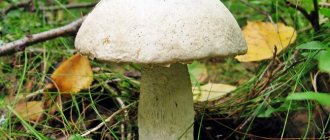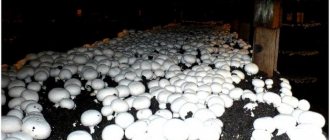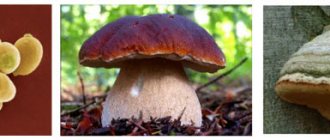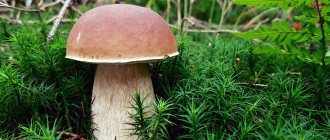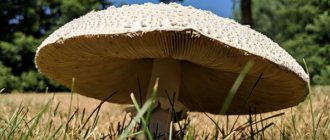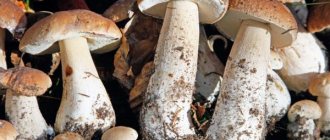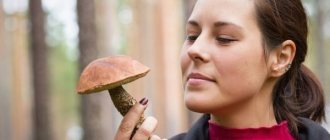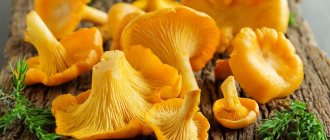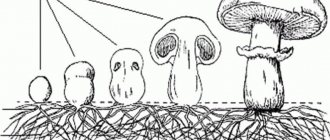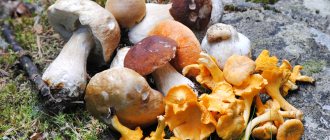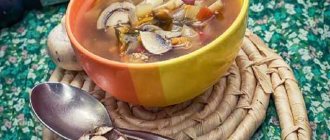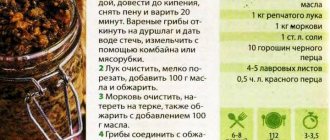How does a mushroom work?
Most mushrooms have a well-defined stem and cap. On the lower surface of the cap, plates or a sponge are visible where the spores are contained. Spores spill out when ripe and are carried by the wind.
The most important part of the mushroom is the mycelium. These are peculiar roots that look like thin threads. Threads or hyphae penetrate the soil, collecting nutrients and moisture from a large area.
Many mushrooms prefer certain landscapes or tree species. Honey mushrooms and oyster mushrooms grow on rotten stumps, among the champignons there are meadow and forest varieties, oak mushrooms are found in oak forests, white mushrooms are found in coniferous forests.
Mushrooms combine the properties of plants and animals. Like animals that consume ready-made substances, the cells are strengthened with chitin. Like plants, they constantly grow, but cannot move, they reproduce by spores, and feed with the help of special organs.
Deadly poisonous
Some of these species are similar in appearance to their edible counterparts, while others are different. You need to understand: if the toxic fruiting body remains in the basket, touching the edible specimens, a certain amount of poison will fall on them. If in any doubt, you should show the found specimen to a more experienced person, and if this is not possible, it is better to throw it away. Ideally, a beginner should not walk through the forest alone at all, but it is best to first learn to distinguish between beneficial and poisonous mushrooms. The most dangerous species are:
red, panther and stinking fly agarics;- death cap;
- spring toadstool;
- Patouillard fibre;
- the most beautiful spider web;
- poisonous entoloma;
- honey fungus sulfur-yellow.
Table 4. Common toxic mushrooms.
| Name | Description |
| Satanic | Deadly, attractive in appearance, with a wide dense leg and a cushion-shaped cap. The skin is velvety, pleasant to the touch, light olive, off-white or gray. The flesh is white, turning red, pink or blue when broken. Favorite places are forest-steppes. |
| Waxy talker | A beautiful mushroom with a pleasant smell. The cap and stem are white, the edges of the plates at the junction with the stem form a fusion. The fruiting bodies are deadly poisonous due to their muscarine content. |
| Death cap | This species has a flattened cap, the color of which can be light green, yellowish, pale brown, dirty pink and others. The upper part of the leg is surrounded by a protective ring that forms folds, and the base seems to be inserted into a similar ring growing from the ground. By this feature, the pale grebe can be easily distinguished from other species. |
| Galerina bordered | Outwardly it resembles a honey fungus, but there is no ring on the stem. It grows singly or in small groups, is found mainly in coniferous forests, and is extremely rare in mixed forests. |
| Patouillard fiber | Belongs to the genus Inocybe and is considered one of the most dangerous. Prefers clay and calcareous soils, grows in parks, gardens, coniferous and mixed plantings, and deciduous forests. Forms small families and large colonies, and can grow alone. The cap and leg are colored the same: in young specimens they are white, in adults they are yellow, and in older specimens they are reddish. There is 20 times more muscarine in fiber than in fly agaric. |
| Stinky fly agaric. | It has no external resemblance to red, but resembles a pale toadstool. Deadly poisonous. When damaged, it emits a pungent odor of chlorine. The cap and leg are whitish or pale yellow, the skin is sticky, slimy and shiny. |
General description of the real milk mushroom and the main types of mushroom
What types of mushrooms are there?
Mushrooms are divided into edible, conditionally edible and inedible. The table shows the names of mushrooms of three groups.
| Characteristics of mushrooms | Name of mushrooms |
| Edible | White |
| Boletus | |
| boletus | |
| Dubovik | |
| Champignon | |
| Oiler | |
| Russula | |
| Morel | |
| Chanterelle | |
| Honey fungus summer, autumn | |
| Oyster mushroom | |
| Conditionally edible | Rows |
| Umbrella | |
| Pig | |
| Deer horns | |
| Gruzd | |
| Volnushki | |
| Line | |
| Inedible | Gall |
| Fly agarics | |
| Toadstools | |
| False honey fungus | |
| False fox | |
| False champignon | |
| Satanic |
Popular message topics
- Sides of the horizon
People many years ago invented an interesting concept called the sides of the horizon. What is it. Let's try to figure it out. These are the main four purposes; they serve for orientation on the ground. When we go - Chemistry in human life
How many schoolchildren sit until the morning reading chemistry textbooks, swearing at the whole world and not understanding why they need it. But once they understand how closely their lives are connected with this field of science, their interest awakens. - About Trees
The first trees appeared about 400 million years ago. They can be found almost everywhere on land. They cannot tolerate extreme cold and severe drought, so they are not found in deserts, in ice and on mountain tops.
Edible and conditionally edible mushrooms
All edible mushrooms do not require prior preparation. They are carefully cleaned of adhered leaves, blades of grass, and lumps of soil. Mushrooms collected in sandy meadows have to be washed to remove the sand. The mucous skin is removed from the boletus cap, and the “skirt” is removed from the stem. Honey mushrooms are also removed from the ring on the stem.
Rice. 1. Autumn honey mushrooms.
Conventionally edible mushrooms must be soaked or boiled, draining the broth. Some are not recommended to be consumed in large quantities (strochok), while others become tasteless if processed ineptly (deer horns).
Rice. 2. Deer horns.
Milk and milk mushrooms are included in the list of conditionally edible due to their caustic milky juice. After soaking, they are a delicious pickled mushroom.
Information for beginner mushroom pickers
If you have the opportunity to go on your first trips to the forest in the company of experienced mushroom pickers, it is better to take advantage of it. An expert will be able to answer questions that arise during the collection process, dispel doubts about specific specimens and suggest effective methods that will help you understand how to distinguish poisonous mushrooms.
When going to the forest, special attention should be paid to the correct and reasonable selection of clothing. It should not restrict movement, but should reliably protect the body and skin from various insects. Shoes should also be closed, without any additional holes: flip-flops and sandals should be put aside for another occasion. A headdress will come in handy: you can use a cap, hat or scarf.
Proper equipment for a mushroom picker
It is recommended to collect in special baskets, which are made from pine shingles, birch bark or wicker. You should not take buckets and containers made of plastic or plastic and plastic bags with you, especially if you plan to collect redheads, boletus and boletus - in such containers they will wrinkle and break.
You definitely shouldn’t pick mushrooms within a radius of 500-1000 m from roads and busy highways. This is due to the fact that mushrooms are characterized by increased sensitivity to harmful substances, toxins and heavy metals that they accumulate in themselves. Such harmful substances certainly cannot be neutralized using heat or heat treatment.
Poisoning can lead to serious and severe consequences, including death. A separate risk category includes children, the elderly and pregnant women. On average, symptoms of poisoning begin to appear 2 hours after eating the fruit. Symptoms are similar to other types of food poisoning: diarrhea, vomiting, severe abdominal pain and general weakness.
Signs of poisoning from poisonous mushrooms
If the above symptoms occur, you should immediately call an ambulance. While waiting for medical workers to arrive, you need to perform gastric lavage, take activated charcoal, stay in bed and drink plenty of water or strong tea.
It may also be helpful to save any remaining cooked mushrooms that may have caused poisoning. This will make it possible to make a diagnosis faster and more accurately.
Is it possible to get poisoned by edible mushrooms?
Sometimes even eating proven mushrooms can lead to poisoning. This may happen for the following reasons:
- Bacteria. If they enter the nutrient medium of the mushroom body, they begin to multiply intensively. Sources of infection can be soil, transportation containers, even unwashed hands. If the fruits are not properly processed, then when consuming them, you can get bacterial poisoning. However, all these bacteria die after heat treatment. But improper pickling, in which the fruits were kept in the same water for a long time at an elevated ambient temperature, or in which no salt was added, can be dangerous.
- Botulism. This can occur with canned foods due to clostridia spores. If pickled mushrooms are stored indoors without access to air, then they may become contaminated.
- Toxins. Mushrooms, like sponges, absorb all the chemicals around them. Therefore, heavy metals and herbicides that get into fruits growing near agricultural lands or industrial zones also enter the human body, causing severe poisoning.
Homemade canned mushrooms can cause botulism
The digestive system has difficulty digesting heavy mushrooms, so they should be eaten in moderation. And people who have problems with the gastrointestinal tract, kidneys or liver should avoid using this product altogether.
Proper preparation is a guarantee of safety
In order to eat conditionally edible types of mushrooms without fear of poisoning, you should learn how to cook them correctly. This applies to the preparation, in particular, of autumn mushrooms, white and black milk mushrooms and spring morels.
A mandatory step is long-term heat treatment. You will need to cook for 40 minutes, then get rid of the water in which the mushrooms were cooked and rinse them thoroughly. After such a strong treatment, all useful substances, including proteins, are preserved. They only get rid of harmful substances that can spoil the taste of the pulp.
Heat treatment eliminates the bitterness and toxicity of mushrooms
Why you can’t destroy poisonous mushrooms
But it is impossible to destroy and exterminate poisonous mushrooms, otherwise this can cause serious harm to the ecosystem and seriously upset the balance of nature. Many spongy and lamellar species that are dangerous for consumption can be used in the treatment of artiodactyl wild animals. Also, these specimens can be used for medicinal purposes by people. For example, such mushrooms help in the treatment of rheumatism, various nervous and mental disorders, lung diseases, oncology and other pathologies.
Alcohol is not a cure for poison
An alcoholic drink will not only not help, but will also worsen the person’s condition. The fact is that alcohol provokes an accelerated movement of toxic substances in the body, which is why the poison begins to act faster.
It is not recommended to combine mushrooms with alcohol, as it enhances the negative effects of mushroom components on the body.
Inedible mushrooms
Inedible or poisonous mushrooms are not eaten in any form. Toxic substances are not destroyed even with prolonged boiling or drying.
The most dangerous of them are mushrooms of the fly agaric family. These are all types of fly agarics and toadstools.
Many edible mushrooms have doubles. They are called false - false honey fungus, false chanterelle. To distinguish a good mushroom from a false one, you need to know the signs of both types. For example, false champignon differs from ordinary forest champignon by its yellowing cut and unpleasant odor.
Rice. 3. False champignon.
It should be remembered that there is no rule for distinguishing an edible mushroom from an inedible one. Not all poisonous mushrooms have a special smell, some clearly differ only in “old” age, the color can change depending on the growing conditions. You can remember the description of the mushroom in the reference book, but it is better to refuse the mushroom at the slightest doubt than to suffer from poisoning. It is impossible to save a person who has been poisoned by toadstool.
You cannot pick mushrooms along highways or near businesses. Mushrooms accumulate substances from the outside world, so pollution from the air and soil enters the fruiting body.
Briefly about which mushrooms can be eaten and which cannot, you can tell in the message “Edible mushrooms and inedible mushrooms” in a lesson on the surrounding world in 2nd grade.
Is there a 100% method for determining the toxicity of a mushroom?
No matter how hard you try, you won’t be able to check with absolute certainty whether a mushroom is edible or not. We can only guess with some certainty.
The most reliable distinguishing feature of edible mushrooms is considered to be the presence of a spongy cap structure, which in harmful specimens is found only in the satanic mushroom. As a rule, false representatives are characterized by a lamellar structure.
Most poisonous mushrooms have a lamellar structure
Interesting facts about mushrooms for primary schoolchildren
Dear Guys!
How many of you like to pick mushrooms? It’s so nice to find a strong boletus or a flock of cheerful foxes in the forest! The famous Russian writer Sergei Timofeevich Aksakov called mushroom picking a quiet hunt, and the mushrooms themselves the children of the forest. How delicious is dried porcini mushroom soup! And salted milk mushrooms. Russian people have long stored mushrooms during the long Orthodox winter fasts.
Among hundreds of thousands of species of fungi, only a small part belongs to macromycetes (from the Greek macro - large, mycete - mushroom). Everything that we are accustomed to calling a mushroom - be it a “cap on a leg”, like that of a boletus or champignon, a puffball ball, a “hoof” of a tinder fungus - is just a fruiting body. Spores are formed on it (or in it), which the fungus needs for reproduction. And in the soil or in a rotten stump there is a mycelium - the vegetative body of the fungus (from the Latin vegetation - growth, growth). The task of the thin threads of the mycelium is to provide nutrition and respiration of the fungus, its growth and spread throughout the area.
If the mycelium of different species is almost the same, then the shapes of the fruiting bodies are unusually diverse. There are cap mushrooms, bowl mushrooms, cup mushrooms, bushes, balls and clubs. The bottom of mushroom caps can be covered with tubes (ceps), plates (russula), spines (hedgehog), folds (chanterelle). Spores develop on their surface. When the mushroom matures, spores are released. They give rise to new myceliums. Spores are visible only under a microscope; they are of different colors and shapes. Scientists use spores to very accurately determine which species the mushroom belongs to.
In the soil, among fallen leaves, in wood and even in water, there live many microscopic fungi - micromycetes (from the Greek micro - small, mycete - mushroom). They are so tiny that they can only be seen with a microscope. Since ancient times, people have used some of them without even knowing it. For example, they baked bread or brewed beer, known since the times of Ancient Egypt, using microscopic fungi - yeast.
These mushrooms can be beneficial to humans. Microscopic molds - penicillin and other antibiotics - treat various diseases. But often mold fungi spoil food. And some micromycetes cause diseases in humans (dandruff), animals (lichen), and plants (powdery mildew). But in our book we will only talk about macroscopic mushrooms, that is, visible to the naked eye.
It is interesting that in Ancient Rus' there was no word for mushroom. It appeared about 450 years ago - during the time of Tsar Ivan the Terrible. This is the name given to tubular mushrooms with a “humpbacked” cap. Compare the Old Slavonic word gurb (hump) and mushroom. It seems? Before this, all mushrooms were called lips. This nickname has been preserved in some Slavic languages (for example, in Czech) and to this day, lips are called tinder fungi in some rural areas of Russia and Ukraine
Mushrooms are neither plants nor animals. They are united into a separate group of living organisms - the Kingdom of Mushrooms. In the science of biology, a kingdom is a very large group of living organisms.
There are many people who like to eat mushrooms in the forest: squirrels store them for the winter, and they are eaten by mice and voles. Gnawing marks are often visible on the caps - traces of the teeth of these animals.
Cartoonists and children's book illustrators love to depict a hedgehog with apples and mushrooms impaled on its prickly back. The usual menu for a hedgehog is insects and their larvae, snails, earthworms, frogs, lizards, and bird eggs. A hedgehog can eat a forest apple that has fallen to the ground, but it does not prick the fruits or mushrooms on its thorns. The author of this fable is the ancient Roman scientist Pliny, who “launched” it into the light about 2 thousand years ago.
Who else eats mushrooms? Elks, wild boars, deer. One mushroom is even called deer spittle. Naked slugs sometimes eat the caps so much that they become full of holes. You can find hard yellow “worms” in the mushrooms—the larvae of click beetles and small black, fidgety rove beetles. You can see a dung beetle in the thick stem of a white mushroom or boletus. It turns the mushroom pulp into dust. But the most important consumers of “forest meat” are the larvae of fungus gnats and flies. These are the same “worms” that spoil our mushroom hunting.
Many people believe that worms do not live in poisonous mushrooms. This is not true. Both fly agarics and toadstools can be wormy. So the surest way not to get poisoned by mushrooms is to know them well and be able to distinguish between edible and poisonous mushrooms.
It happens that you are unlucky with mushroom hunting: you don’t come across white boletuses, aspen boletuses, you don’t see any russula or chanterelles. So, should we leave the forest? Let's look at the world of mushrooms with different eyes - let's admire the grace and beauty of various mushroom trifles. Usually, on forest litter (last year's half-rotten leaves, pine needles) there are clusters of cute fungi with thin legs. The hats of such delicate creatures are no more than a centimeter in diameter. The British call them “fairy hats”. Most often, the babies are painted in modest grayish and brownish tones, but there are also bright ones: pink, yellow, purple. There are even smaller fungi, whose caps are only 3-5 mm, and whose legs are slightly thicker than horsehair. These little ones settle on dead blades of grass, needles, and thin twigs. We will not list their names; fungi belong to different families. You can put several of the ones you like most in a box (it would be nice to have one in case of interesting forest finds), and examine them at home with a magnifying glass.
Answers to common questions
Is it possible to identify a poisonous species by smell? In some cases it is possible. But if there is no specific smell, then other characteristic signs must be taken into account.
Is it true that when cooking poisonous mushrooms the water turns blue? Water acquires this color due to the presence of hydrocyanic acid, and it can be not only in dangerous forms.
Is it true that dropping a silver spoon into a pan of poisonous mushrooms will turn dark? Silver darkens as a result of exposure to certain groups of amino acids containing sulfur, which are present both in the pulp of certain poisonous species and in the pulp of edible species. Darkening only indicates the absence of specific amino acids.
What is first aid for poisoning? First of all, you need to call an ambulance, provide bed rest and plenty of fluids (cold water, cold strong tea), and drink activated charcoal.
Various experts agree that common “folk” methods of testing a product for edibility cannot protect against poisoning. Therefore, it is better to leave any dubious find in the forest.
First aid for mushroom poisoning
If, after eating mushrooms, you feel unwell - dizziness, nausea, abdominal pain, shortness of breath and other suspicious symptoms, immediately:
- Call an ambulance.
- Rinse your stomach. To remove the poison from the body, you need to induce vomiting. Drink 1-2 liters of dissolved potassium permanganate or sorbents - white/activated carbon (1 g per 1 kg of body weight).
- If there is no coal and potassium permanganate, take table salt. Dissolve 2 tablespoons of salt in a glass of water and drink - the saline solution has a laxative effect.
- After removing toxins, you need to replenish fluid losses - drink mineral water or sweetened tea.
When collecting and consuming mushrooms, using “folk methods” is not only ineffective, but also dangerous. Only studying the appearance and special signs of mushrooms - edible and deadly poisonous - will help you avoid a fatal mistake.
